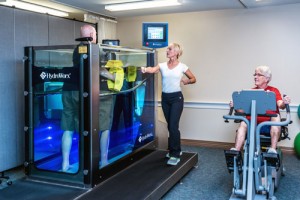Effectively Addressing Issues Related to Lack of Mobility for Seniors
One of the realities of working with a population of seniors is that the majority of them will face mobility issues. For some, the lack of mobility is temporary, as in the case of a client who is returning from surgery. Yet others have permanent mobility concerns that can be mitigated, but are unlikely to completely disappear. For them, quality of life is a serious consideration because they want to be able to do as much as possible. At the same time, they must feel confident making normal, everyday movements without the risk of falling. It’s a conundrum faced by senior living providers and personnel across the country: How to effectively serve seniors with limited mobility.
How To Address Mobility Challenges In Seniors
Here are a few measures that we’ve seen implemented to address mobility challenges among older adults:
Offer alternative ways for seniors to get in and out of rooms, buildings, pools, etc.
This may include anything from making sure that there are always wheelchairs or assistive devices handy, to investing in an aquatic therapy pool that has a variable-depth floor that can be raised and lowered. The more options that your population has for moving from one situation to the next during their days, the greater their participation in activities. This helps ward off the feelings of alienation and isolation that can lead to depression among the aging.
Provide activities for residents that do not center around a need for excessive mobility.
If your programming involves the need for mobility from seniors, those who are lower-functioning will avoid socializing, which is an integral component to developing a robust senior living community. Activities can include listening to a concert, participating in a Bible study group or even attending a lecture on a topic of interest.
Make it less painful to move.
Pain is one of the leading reasons that residents in senior living facilities hesitate to move around, thus making their mobility problems worse. One of the best tools to combat physical discomfort and improve the mobility of patients is aquatic therapy and exercise sessions. People are willing to walk on an underwater treadmill, perform balance-related exercises, stretch and work their cardiovascular systems because they feel less pain in the water. The added bonus is that the pool fosters circulation. When they leave aquatic therapy or exercise classes, they continue to feel a surge of energy and lowered perception of achiness.
Give them incentives to work on their mobility.
All of us are receptive to incentives, and that includes seniors who could improve their mobility. Incentivizing your population may take a bit of creativity; after all, not everyone is motivated by the same things. However, one tool we’ve seen used is an underwater video camera that provides real-time feedback on screen. Seniors can proactively make gait and other physical improvements, as well as watch themselves get stronger. Make no mistake – this is an enormous motivator.
Add appropriate sports-inspired drills as part of exercise programs.
Even someone in a wheelchair has the ability to catch or throw a lightweight ball, and this assists with coordination and balance. While some forms of athletics are simply not possible within most senior living communities, others are acceptable. Swimming, water aerobics and light underwater jogging are all ways to stimulate movement and combat mobility problems.
Ask your residents and clientele what they want to do.
You might be surprised to learn that there are ways for your residents to move comfortably that you’ve never thought of, but that your clients have. You could discover that a small population of your community wants to engage in more aggressive mobility exercises, and if it fits with your scheduling and personnel limits, you may want to try their suggestions. For example at Saluda Nursing Center, some patients, when trying to overcome temporary mobility concerns caused by accidents or surgeries, ask to be given the “drill sergeant” treatment! They know that they’ll be pushed, and they’re ready to handle this assertive style of rehab and mobility-enhancement. True case: One patient who came to Saluda with a spinal injury was told he would never walk again. He was in his 70s, and wanted to be able to go home eventually. He went through very intensive aquatic therapy using their state-of-the-art therapy pool and land-based therapy. In 13 months, he walked out of Saluda under his own power.
There is a true joy in being able to help someone overcome mobility problems using innovative methods. Anyone who works with seniors should recognize that even if someone seems to be immobile, he or she needn’t feel like a prisoner. Does it take investment and calculated risks? Sometimes. But it’s well worth the results: Clients who feel that you’ve taken a true interest in their emotional, social and physical well-being.
To learn more about why water works so well for senior living communities, download our tipsheet>>



